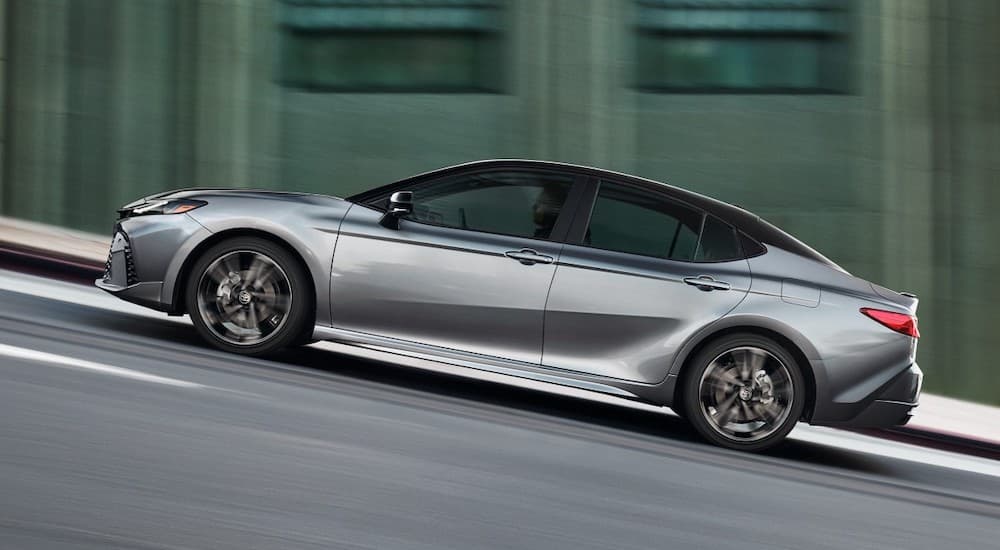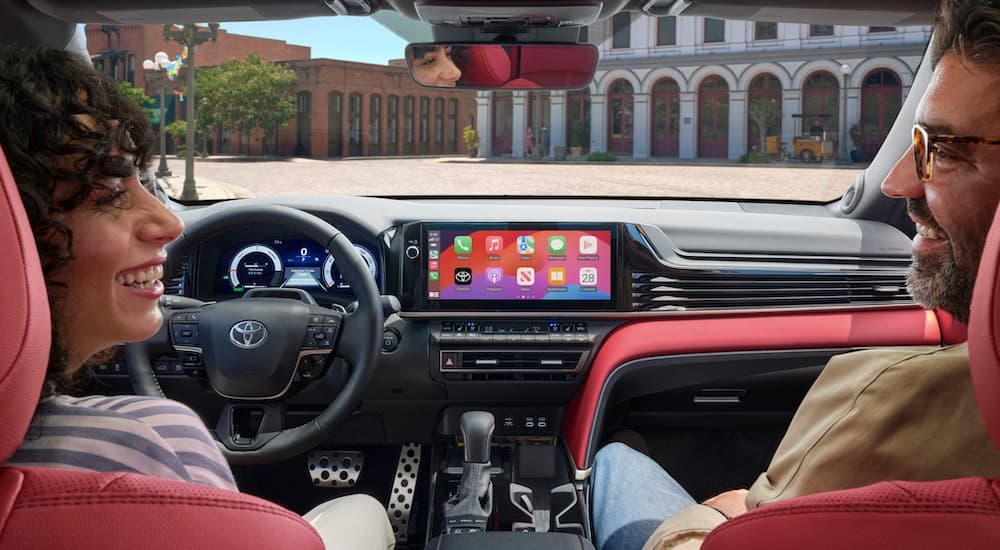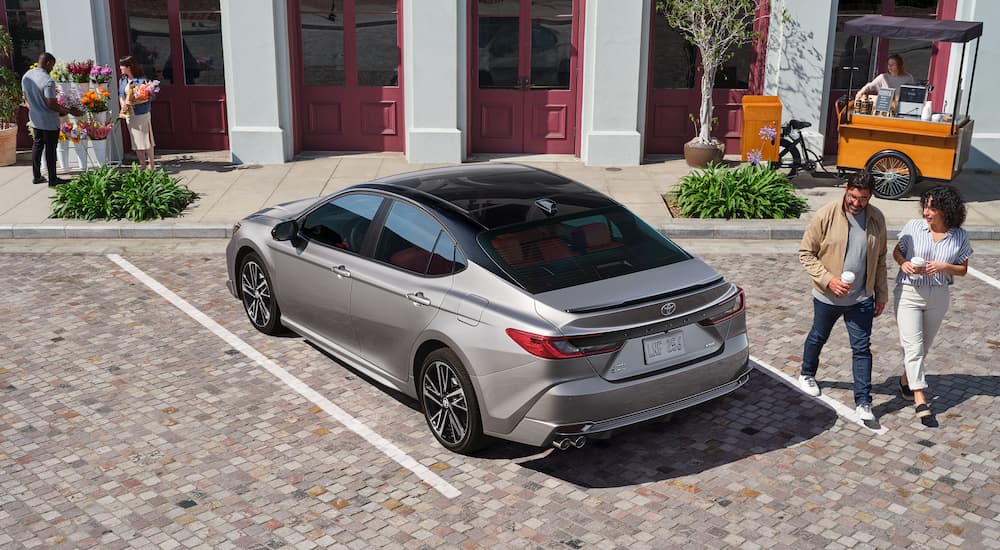Toyota is an automaker well known for making hybrids, and that goes beyond just the Prius. These days, you can get just about any type of vehicle as a hybrid from Toyota, from a minivan (Sienna) to a pickup truck (Tacoma or Tundra) to a full-size SUV (Sequoia). With cars, Toyota is taking the next step forward, converting some models that previously offered both conventional and hybrid powertrains into hybrid-only vehicles. That was the case for the full-size Crown when it returned to the lineup for the 2023 model year, and as of the 2025 model year, it’s true for the midsize Camry as well.
If you’re looking at a Toyota Camry Hybrid for sale, odds are good that fuel economy is important to you. Whether that’s for environmental or economic reasons, you can get a lot out of not just looking at the Camry’s fuel economy ratings, but comparing those ratings to your other options so you can make a smart decision. Today, we’re going to do just that. We’ll let you know how far various trim levels of the Camry can go on a gallon of gas and put that in context compared to other Toyota cars and midsize sedans from other automakers.
Fuel Economy of the Camry Across Trim Levels
If you go to Toyota’s website and click on the page for the Camry, you’ll find a single fuel economy figure (51 MPG) in the car’s “highlights,” but if you click the asterisk after that number, you’ll see that the number doesn’t apply to all trim levels. Most (if not all) automakers do the same thing, highlighting the best stat they offer without putting much of a spotlight on the details. So let’s take a more complex look at what kind of fuel economy you can expect from the Camry.
The base LE trim, paired with front-wheel drive, offers the best fuel economy. This Camry gets you 53 MPG in the city and 50 MPG on the highway, for a combined rating of 51 MPG. If you decide to upgrade to all-wheel drive in order to get better traction on wet roads and gravel driveways, those numbers will drop slightly, and you’ll end up with a city/highway combined rating of 50 MPG. The SE, XLE, and XSE trims all have a higher curb weight than the LE, and the SE and XSE have a different suspension system designed for sportier performance, which explains why none of these trims can match the LE’s fuel economy figures.
Paired with front-wheel drive, the higher trims deliver 48 MPG in the city and 47 MPG on the highway, for a combined rating of 47 MPG. With all-wheel drive, the SE and XLE both offer 46 MPG no matter where you’re driving. The top-tier XSE trim paired with AWD has the worst fuel economy of the lineup, getting an estimated 44 MPG in the city and 43 MPG on the highway for a combined rating of 44 MPG.
Of course, all of these figures exist in a wider context than just the Camry lineup. Before we look at other vehicles you might be considering if you’re shopping for a Camry, we can compare these figures to the average fuel economy of an average 2024 vehicle. According to the EPA, that average is a mere 28 MPG. The most efficient Camry is 1.8x as efficient as that average, and even the Camry XSE with AWD is 1.5x as efficient. But you could already have guessed that a hybrid sedan would be highly efficient compared to an average that accounts for all kinds of non-hybrid SUVs and pickup trucks. So, let’s shift our focus to the vehicles that are in the same league as the Camry.
Where the Camry Fits Into Toyota’s Lineup of Cars
First, let’s take a look at the other cars in Toyota’s lineup. We’ll ignore performance models like the GR Supra and GR86 that definitely prioritize horsepower over fuel economy and as such rank significantly lower than the others and the hydrogen-powered Mirai, which has limited availability thanks to its niche fuel source. That leaves us with the compact Prius and Corolla and the full-size Crown.
As you might expect, the larger Crown is less efficient than the Camry across the board, despite also being available exclusively as a hybrid. In addition to its larger size, the Crown also has standard all-wheel drive, so you also can’t get better fuel economy by opting for rear- or front-wheel drive. Most trims of the 2025 Crown offer 42 MPG in the city and 41 MPG on the highway for a combined rating of 41 MPG, while the sportier Platinum trim has a more powerful engine that brings those figures down to 29 MPG in the city, 32 MPG on the highway, and 30 MPG combined.
The compact Corolla is a little more complicated. Even though it’s a smaller vehicle, it can’t quite match the Camry’s best fuel economy figures. The two most efficient trims (Hybrid LE FWD and Hybrid XLE FWD) are off by just one, with a combined city/highway rating of 50 MPG compared to the Camry LE’s 51 MPG. The least efficient hybrid trims (Hybrid SE AWD and Hybrid Nightshade AWD) offer only 44 MPG for city/highway combined driving. Unlike the Camry, the Corolla is still available with a non-hybrid powertrain as well. With this setup, the best you can get is 35 MPG for city/highway combined driving, the rating for the Corolla LE sedan, SE hatchback, and Nightshade hatchback. The hatchback body style, which has an open cargo area rather than a sealed trunk, can’t be paired with the hybrid powertrain.
That leaves just one contender, but you might have already guessed that the Prius would be a tough model to beat when it comes to fuel economy. You’d be right: even the least efficient 2024 Prius trims (XLE AWD and Limited AWD) get 49 MPG in the city and 50 MPG on the highway for a combined rating of 49 MPG, beating out most trims of the Camry. At its most efficient, the Prius LE FWD can deliver 57 MPG for city/highway combined driving, more than double what the average 2024 vehicle gets. Opt for the plug-in hybrid Prius Prime, and you can get up to 127 MPGe (miles per gallon equivalent) with a fully charged battery. This makes the Prius the clear call if you want the most efficient Toyota, but if you want a larger cabin, then the Camry is still a competitive choice that isn’t too far behind some of the trims on the fuel-sipping eco icon.
How the Camry Compares to Other Midsize Sedans
What if we look beyond just Toyota and compare the Camry to its direct competition: other midsize sedans. Well, as you might expect, non-hybrid options don’t come close. The Chevy Malibu, Subaru Legacy, and Kia K5 all get a combined city/highway rating of 30 MPG with their most efficient options, just barely surpassing the average of 28 MPG and not coming close to the Camry’s 51 MPG. The Nissan Altima fares a little better, but not by much, with 32 MPG. Other hybrids come a lot closer but can’t quite catch the Camry. The popular Honda Accord Hybrid gets 48 MPG, while the Hyundai Sonata Hybrid gets 47 MPG.
Any Way You Look at It, the Camry is an Efficient Choice
Clearly, the Camry is a fuel-efficient option in just about any context. While it can’t quite match the green street cred of the Prius, it’s more efficient than many of the cars in Toyota’s lineup, easily beats both non-hybrid and hybrid midsize sedans made by other automakers, and is nearly twice as efficient as the average 2024 vehicle. Some trims are better than others, but whichever one you pick is sure to help you avoid pain at the pump and make you feel like you’re doing your part for the planet.






